Roshan Malik
Bahawalpur State (1833-1955) has a unique architecture blended with Italian style. It was comprised of three districts (Bahawalpur, Bahawalnagar and Rahim Yar Khan). The last ruler Nawab Sir Sadiq Muhammad Khan Abbasi V ruled the State (1907-55) before it merged into the unitary province of Pakistan. The State reached the zenith of its glory under his rule, as he transformed Bahawalpur into an excellence of learning and centre of architecture. Various schools, colleges, palaces, mosques, hospitals and a library and university were built during his time.
Since ATP readers have already been talking about Bahawalpur architecture through the Photo Quiz on Noor Mahal and then again on the Baghdad-ul-Jadeed Railway station, it makes sense to talk about this scope and history of this architectural heritage at greater length.
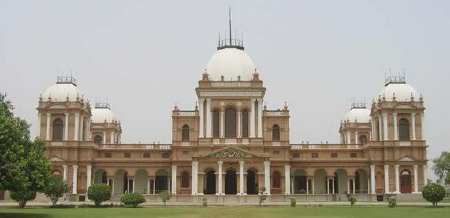
Sadiqgarh Palace (Sleeping Beauty Castle) is situated at Dera Nawab Sahib (Ahmedpur East), about 30 miles away from Bahawalpur, was the headquarters of the State.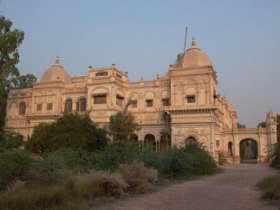 More than 1000 employees were deployed for the maintenance and beautification of the Palace and its lush green lawns. Nearly 100 rooms were decorated with crystal chandeliers, drapes, paintings and carpets.
More than 1000 employees were deployed for the maintenance and beautification of the Palace and its lush green lawns. Nearly 100 rooms were decorated with crystal chandeliers, drapes, paintings and carpets.
After Nawab’s death, the Palace had been sealed by the government for many decades due to a dispute among heirs. Many antiques had been stolen from the Sadiqgarh Palace and were sold in cities like Lahore, Karachi and Islamabad. The building of that glory now gives a deserted and shabby look surrounded by wild shrubs. The palace desperately needs maintenance and repair for the restoration of its grandeur.
Noor Mahal and Gulzar Mahal are the most elegant buildings in Bahawalpur built in the Italian style. Both the buildings are now under the control of Army. However, the army purchased the Noor Mahal some years back by paying Rs. 120 million to the heirs. It is unique in its architecture and is splendid with beautiful lawns and driveways.
 The late Nawab established various educational institutes in the State such as Islamia University Bahawalpur, Sadiq Public School Bahawalpur, Sadiq Egerton College Bahawalpur, Sadiq Dane High School Bahawalpur, Jamia Masjid al Sadiq Bahawalpur. The Central Library Bahawalpur is another landmark of Bahawalpur architecture which was built in 1924. This is the second largest library in Punjab having various manuscripts and rare books.
The late Nawab established various educational institutes in the State such as Islamia University Bahawalpur, Sadiq Public School Bahawalpur, Sadiq Egerton College Bahawalpur, Sadiq Dane High School Bahawalpur, Jamia Masjid al Sadiq Bahawalpur. The Central Library Bahawalpur is another landmark of Bahawalpur architecture which was built in 1924. This is the second largest library in Punjab having various manuscripts and rare books.
The famous Fort Derawar was once the capital of Bahawalpur State. It was built in thirteenth century by the Rajputs of Jaiselmer. The Nawabs of Bahawalpur conquered it in eighteenth century. It was a birth place of many Nawabs. The rulers of Bahawalpur give great importance to Derawar as their royal cemetery is near Derawar.
Derawar is about 65 miles away from Bahawalpur in Cholistan desert. The historic Derawar Fort, enormous and impressive structure in the heart of Cholistan desert, is rapidly crumbling and if the immediate preventative measures are not taken, the edifice will be destroyed and the historians, researchers and sightseers deprived of the view of the legacy of the bygone era.
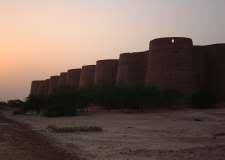
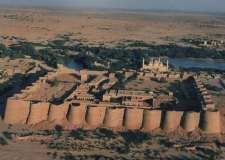
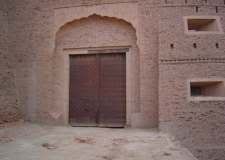
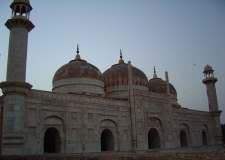
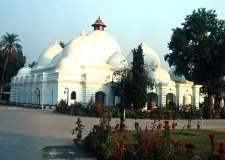

The legacy of Bahawalpur state has been in ruins like many other historical places of the country. These building have potential to attract a great deal of tourists. But what the heirs and the government need is a good planning and political will. Otherwise it will turn into sands like many other forts in Cholistan like Maujgarh, Dingarh, Islamgarh and Marot.
The cluster of 6 pictures, above, includes: (1) One of the still-intact but crumbling walls of Fort Derawar, (2) Aerial view of the fort, (3) Mosque Derawar, (4) Entrance to Fort Derawar with potholes, (5) Services Club Multan, was once Rest House of Nawab of Bahawalpur, (6) Sadiq Public School, Bahawalpur.
Roshan Malik is a development practitioner from the Bahawalpur region.



















































@Pervaiz Munir Alvi
There are a number of books in Central Library Bahawalpur about the history and architecture of the State. No doubt we need to have more research on its architects and architecture of these buildings.
@zamanov
The army is in the possession of Gulzar Mahal where the Nawab used to live during his visit to Bahawalpur as it is adjacent to Darbar Mahal where he used to hold his court. Now there is no public access to both Gulzar Mahal and Darbar Mahal.
Regarding Noor Mahal, I think recently it has been transformed into an army mess so no public access again. Regarding Services Club Multan (Pic 5) used to be Nawab’s rest house in Multan is now a Club of civilians and army elite similar to Islamabad club or Lahore gymkhana club.
I wish that the public should have access to our cultural heritage and it would have been a great attraction for the tourists to visit Bahawalpur.
Fascinating. Never been to Bahawalpur but am amazed at the pictures. They look stunning.
Given that the government is not exactly up to the task of maintaining these architectural masterpieces, is there another way of approaching this problem? Could corporations be involved in such an undertaking? Could schools of architecture be motivated to take scholarly interest in not just the history but preservation of such heritage?
“Noor Mahal and Gulzar Mahal are the most elegant buildings in Bahawalpur built in the Italian style. Both the buildings are now under the control of Army. However, the army purchased the Noor Mahal some years back by paying Rs. 120 million to the heirs.”
What role does the army have in preserving the historical heritage of the country? Which fund did the Rs. 120 million, to pay the heirs of the Noor Mahal, come out of? Is there no other organization or government entity left in Pakistan to purchase, maintain and upkeep these priceless architectural masterpieces? Will the military owners now allow the public to visit and enjoy our own cultural heritage for a nominal fee?
Mr Malik thank you for writing about this amazing piece of history in our own backyard.
Nice posts and great selection of pictures. Ashamed to say I have never been to Bahawalpur and never thought of going there. Now certainly will. Any information on the architects of these buildings.
“a unique architecture blended with Italian style.”
“Noor Mahal and Gulzar Mahal are the most elegant buildings in Bahawalpur built in the Italian style.”
Thank you Roshan Malik for treating us with this beautiful posting. More needs to be said about Bahawalpur and its history. These buildings are good examples of ‘British Period Architecture in Pakistan’. One could find structures similar to these in Imperial France of seventeen and eighteen century. French palaces in Versailles, Paris, and even many structures in Victorian England were inspired by these styles. I for one would be interested in learning names of the architects behind these structures. I have feeling they were British in their origin. These, like other British period structures in Pakistan are architecturally ‘hybrid’ and there fore hard to pin down as Italian, or French, or British for say. But that is what is interesting about them anyway. These are Pakistani structures and should be viewed as such. It is sad that we Pakistanis are unable to save our fabulous heritage. Sad indeed.